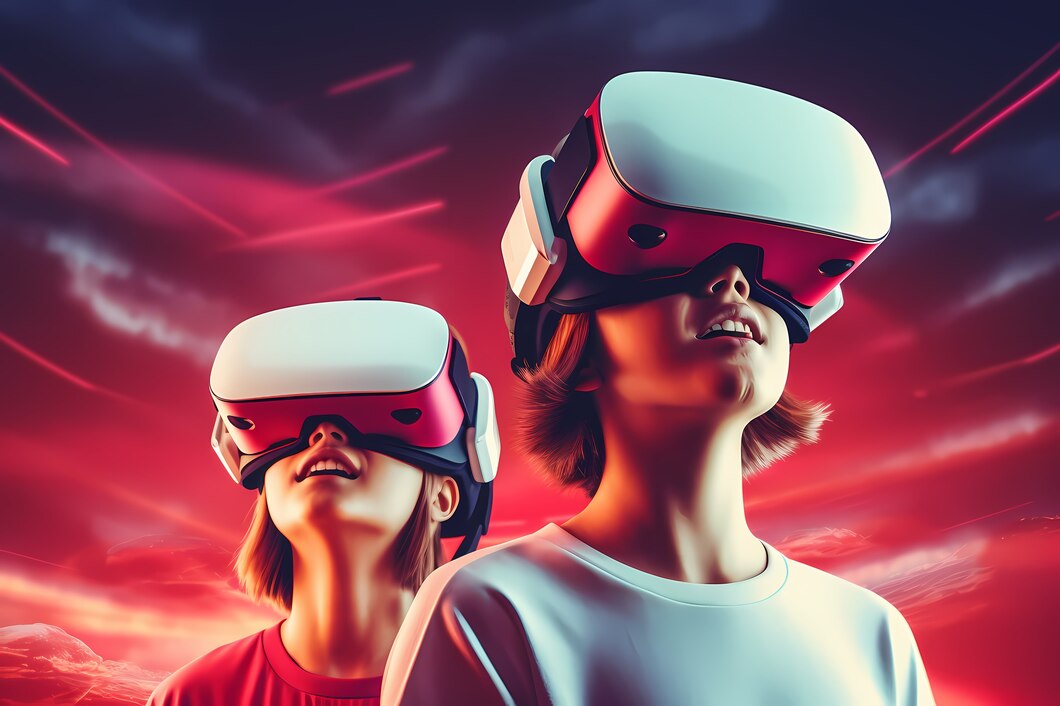Introduction
The entertainment and film industries are being revolutionized by virtual reality (VR), a technology that immerses users in digital worlds and transforms the way stories are told and experienced. From interactive films to virtual concerts, VR Entertainment Film Industry is opening new doors for creators and audiences alike, creating a future where traditional media formats are being pushed to their limits.
The Rise of VR in Entertainment

VR technology has made significant strides in recent years. Initially used mainly for gaming, it is now being adopted by filmmakers and content creators to enhance storytelling. By immersing audiences in a 360-degree environment, VR allows them to experience stories in a way that traditional media cannot. This immersive quality is attracting filmmakers looking to push the boundaries of narrative and engage viewers on a deeper level.
Virtual reality is not just a futuristic concept anymore; it’s an evolving technology that has become a key player in the entertainment industry. VR headsets, such as the Oculus Rift, HTC Vive, and PlayStation VR, are making immersive experiences available to mainstream audiences. With VR, viewers are no longer passive observers but active participants in stories. As this technology continues to evolve, it’s reshaping the ways we interact with films, concerts, and video games.
Immersive Storytelling: A New Frontier for Filmmakers

For filmmakers, VR has created an entirely new medium. Traditional films offer a single perspective, but VR allows viewers to explore 360-degree environments, giving them control over what they see and when. This immersive storytelling offers filmmakers a more creative and dynamic approach to how they share narratives. For example, VR films like Wolves in the Walls and Spheres let users move through scenes and engage with characters in ways that are impossible in traditional cinema. This opens up new possibilities for genres like science fiction, fantasy, and horror, where environment and atmosphere are crucial elements.
Benefits of VR in Filmmaking
- Enhanced Storytelling: VR enables filmmakers to create narratives that engage audiences more actively. Viewers can explore environments, interact with characters, and make choices that affect the story outcome.
- Increased Audience Engagement: The immersive nature of VR captures the viewer’s attention more effectively than traditional film. This heightened engagement leads to stronger emotional connections to the content.
- Creative Opportunities: Filmmakers can experiment with innovative storytelling techniques. The possibilities are limitless, from creating unique perspectives to building interactive narratives.
VR Concerts and Live Events: The Future of Entertainment

The COVID-19 pandemic forced many live events, including concerts, to be canceled or moved online. During this time, VR emerged as a vital tool for hosting virtual concerts and events. Artists such as Travis Scott and Marshmello have held immersive VR concerts on platforms like Fortnite, attracting millions of viewers. This has given fans the ability to feel as though they are attending a live performance, complete with interactive features, even from the comfort of their homes.
These virtual concerts are just one example of how VR is bridging the gap between live and digital experiences. Fans can experience front-row seats and even interact with the environment, creating a more personal and engaging experience compared to traditional online streams.
Gaming and the Blurring of Reality and Fiction

The gaming industry has been an early adopter of VR technology, and it’s also been a key driver of its growth. VR gaming takes the experience beyond the screen, placing players directly into the game world. Popular VR titles like Beat Saber, Half-Life: Alyx, and No Man’s Sky VR give players a level of immersion that wasn’t possible before. In these environments, players can interact with objects, explore landscapes, and solve puzzles using their physical movements.
In addition to entertainment, VR gaming has expanded into other areas like fitness, with apps like Supernatural and FitXR offering virtual workouts. This blurs the line between gaming, physical exercise, and entertainment, showcasing the wide-reaching applications of VR.
VR Film Production: Challenges and Opportunities

While VR has great potential, it also presents several challenges for filmmakers. Traditional film production techniques don’t always translate well into VR, where the audience can choose where to look at any given moment. This means filmmakers must think about storytelling in entirely new ways, considering how to guide the audience’s attention without the use of traditional cinematic techniques like cuts or close-ups.
The cost of VR production is another challenge. High-quality VR films require significant investments in technology, including 360-degree cameras and advanced software for stitching footage together. However, as VR technology becomes more affordable, we can expect more filmmakers to experiment with this format.
Despite these challenges, the opportunities are vast. VR opens the door to new forms of interactive storytelling, where viewers can make decisions that influence the plot or explore hidden areas of the environment. This type of engagement is especially appealing to younger audiences who are accustomed to interactive media.
Challenges of VR Adoption
Despite its advantages, VR also presents several challenges for the entertainment and film industry:
- High Production Costs: Creating VR content can be expensive. Filmmakers need specialized equipment and skills, which can increase production budgets significantly.
- Technical Limitations: Not all audiences have access to high-quality VR headsets. This limitation can hinder the widespread adoption of VR films.
- Viewer Comfort: Some viewers may experience discomfort or motion sickness while using VR headsets. Filmmakers need to consider these factors to ensure a positive experience.
The Future of VR in Entertainment and Film

The future of VR in entertainment and film is promising, with continual advancements in technology making virtual experiences more accessible and engaging. As VR headsets become more affordable, we can expect to see more VR films, concerts, and live events. Companies like Netflix and Disney are already exploring how to incorporate VR into their offerings, while indie filmmakers and musicians are also using the technology to stand out in an increasingly competitive market.
Comparative Table: Traditional vs. VR Entertainment
| Aspect | Traditional Entertainment | VR Entertainment |
|---|---|---|
| User Engagement | Passive viewing experience | Active and immersive experience |
| Storytelling | Linear, with fixed narrative | Non-linear, allows exploration and interaction |
| Audience Control | Limited to what the director shows | Full control over where to look and explore |
| Technology Cost | Generally low, accessible with basic devices | High initial cost for headsets and VR production |
| Interactivity | Minimal, usually through traditional media formats | High, allowing users to engage with the environment |
| Genres | Traditional genres like drama, comedy, etc. | Science fiction, horror, and fantasy are greatly enhanced |
Analysis Table: VR’s Impact on the Film and Entertainment Industry
| Area of Impact | Effect of VR |
|---|---|
| Film Production | Requires new storytelling methods, but offers more immersive experiences |
| Concerts and Live Events | Makes virtual concerts possible, allowing global audiences to “attend” |
| Gaming | Expands interactive possibilities, blurring lines between reality and fiction |
| Audience Engagement | Increases engagement by allowing users to actively participate |
| Technological Barriers | High production and technology costs, but prices are gradually decreasing |
| Future Potential | Expected to grow as VR technology becomes more mainstream |
Conclusion
VR is undeniably changing the landscape of the entertainment and film industries, offering new ways for creators to engage with their audiences. While there are challenges, such as the high cost of production and the need for new storytelling techniques, the benefits are clear. Audiences are no longer just watching; they are stepping into new worlds, interacting with stories, and becoming part of the experience. As technology continues to evolve, VR will only become a more integral part of how we consume entertainment.




